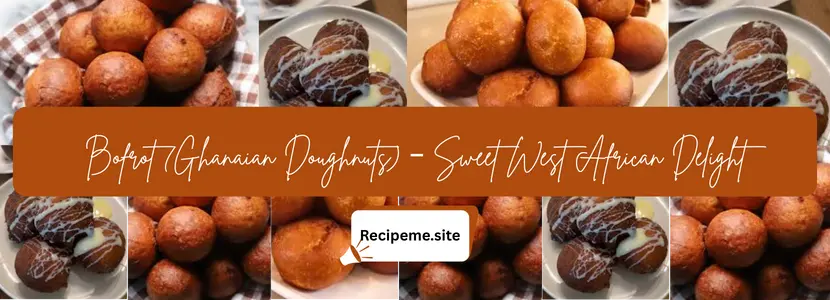
Introduction
Who doesn’t love the smell of something sweet and golden frying in hot oil? The kind of aroma that instantly makes you hungry even if you just ate? That’s the magic of Bofrot (Ghanaian Doughnuts).
Whether you’re in a bustling Ghanaian market, a family gathering, or a street corner at dawn, you’ll likely find vendors selling these warm, round, deep-fried dough balls. They’re not just a snack—they’re memories, traditions, and comfort rolled into one fluffy bite.
But what makes bofrot so special? Why has it stood the test of time, becoming a favorite not just in Ghana but across West Africa? Let’s take a sweet journey to uncover the story of this iconic snack.
History of Bofrot
Bofrot, also called puff-puff in Nigeria and mikate in Congo, has deep roots in West African culinary traditions. This snack originated as a street food staple, sold early in the mornings or late in the evenings.
In Ghana, bofrot is particularly popular among children on their way to school, workers looking for a quick breakfast, and families during festive occasions. Over time, its preparation methods have evolved, but its essence has remained unchanged—soft, fluffy inside with a crispy, golden-brown exterior.
Did You Know? Bofrot has traveled far beyond Africa. Immigrant communities have introduced it to Europe and the United States, where it has become a beloved treat at cultural festivals.
Essential Ingredients for Bofrot
The magic of bofrot is that it uses simple, everyday ingredients to create something extraordinary.
-
Flour – the base of the dough.
-
Sugar – for sweetness.
-
Yeast – to help the dough rise and create fluffiness.
-
Nutmeg (optional) – adds warmth and fragrance.
-
Milk or water – for binding the dough.
-
Salt – to balance flavors.
-
Vegetable oil – for deep frying.
Pro Tip: Adding a touch of nutmeg or vanilla essence elevates the flavor profile, making your bofrot irresistible.
Variations of Bofrot
While the traditional Ghanaian bofrot remains the most popular, different regions and families have created variations:
-
Classic Bofrot: The traditional sweet doughnut ball.
-
Spiced Bofrot: Enhanced with nutmeg, ginger, or cinnamon.
-
Stuffed Bofrot: Filled with chocolate, jam, or coconut for a modern twist.
-
Savory Bofrot: Less sugar, sometimes paired with pepper sauce.
-
Mini Bofrot Bites: Smaller versions, perfect for parties and kids.
Preparation: Step-by-Step Guide
Here’s a simple method to make fluffy bofrot at home.
Ingredients (serves 6):
-
3 cups all-purpose flour
-
½ cup sugar
-
1 tbsp dry yeast
-
½ tsp nutmeg (optional)
-
¼ tsp salt
-
1 cup warm milk or water
-
Vegetable oil for frying
Instructions:
-
Activate the Yeast
-
Mix yeast with warm water or milk and a teaspoon of sugar. Let it sit until foamy.
-
-
Prepare the Dough
-
In a bowl, combine flour, sugar, salt, and nutmeg. Add the yeast mixture and mix into a smooth dough.
-
-
Let it Rise
-
Cover and leave in a warm place for about 1 hour until the dough doubles in size.
-
-
Heat the Oil
-
Heat oil in a deep pan. Test with a drop of dough—it should rise and sizzle immediately.
-
-
Shape and Fry
-
Scoop small portions of dough and drop gently into the oil. Fry on medium heat until golden brown.
-
-
Drain and Serve
-
Remove with a slotted spoon, drain on paper towels, and enjoy warm.
-
Did You Know? The secret to evenly cooked bofrot is maintaining medium oil temperature—too hot, and the outside burns while the inside stays raw.
Cultural Significance of Bofrot
In Ghana, bofrot is more than food—it’s a symbol of community. Vendors sell them on street corners, creating lively spots where people gather, chat, and share moments.
It is also common during festivals and celebrations, where large trays of bofrot are served to guests. For many Ghanaians abroad, making bofrot is a way to connect with home and preserve cultural identity.
Serving Suggestions
Bofrot is versatile and can be enjoyed in many ways:
-
With porridge (koko) for a traditional Ghanaian breakfast.
-
With soft drinks or tea as a midday snack.
-
Stuffed with cream, chocolate, or jam for a dessert twist.
-
Served plain, dusted with powdered sugar for extra sweetness.
Types of Bofrot
While the core recipe is the same, there are subtle differences in how it’s prepared:
-
Round Puffy Bofrot: The most common style, airy and soft.
-
Flat Bofrot: Pressed slightly before frying, making them denser.
-
Palm Oil Bofrot: Traditional version fried in palm oil for richer color and flavor.
-
Festival Bofrot: Larger sizes made for parties and community events.
Tips for Perfect Bofrot
-
Use warm—not hot—water when activating yeast.
-
Don’t rush the rising process; fluffy bofrot requires patience.
-
Fry on medium heat for even cooking.
-
Drain properly to avoid excess oiliness.
-
For a healthier option, bake instead of deep fry (though the texture changes).
Other Valuable Insights
-
Nutritional Value: While high in carbs and fat, bofrot provides quick energy—perfect for busy mornings.
-
Hidden Fact: In some Ghanaian traditions, bofrot is shared during weddings and naming ceremonies as a sign of joy.
-
Expert Tip: Mixing half milk and half water makes the dough richer and tastier.
Personal Experience: My Journey with Bofrot
The first time I had bofrot was at a Ghanaian wedding. A tray of hot, golden balls was passed around, and the moment I bit into one, I understood why people love them so much. The crispy outside gave way to a soft, warm center that felt like comfort in food form.
Now, every time I make bofrot at home, it reminds me of that joyous day. It’s not just a snack—it’s laughter, music, and togetherness wrapped in dough.
Conclusion
Bofrot (Ghanaian Doughnuts) is more than a sweet treat—it’s a cultural treasure. From its simple ingredients to its role in family gatherings and festivals, bofrot continues to bring joy to people across West Africa and beyond. Whether enjoyed with porridge, tea, or stuffed with chocolate, one thing is certain: bofrot is proof that the best things in life are often the simplest.
Frequently Asked Questions (FAQs)
1. What is bofrot made of?
Bofrot is made from flour, sugar, yeast, nutmeg, and water or milk, deep-fried until golden brown.
2. Is bofrot the same as puff-puff?
Yes, they are similar. In Nigeria it’s called puff-puff, while in Ghana it’s called bofrot.
3. Can bofrot be baked instead of fried?
Yes, but the texture will differ—it will be less crispy.
4. How long does bofrot stay fresh?
Freshly made bofrot is best eaten within a day but can last up to 2 days in an airtight container.
5. Can I make bofrot without yeast?
Yes, but baking powder versions are denser and not as fluffy.
6. Why is my bofrot oily?
This happens if the oil is not hot enough or if the dough is too wet. Fry at medium heat and avoid overcrowding.
